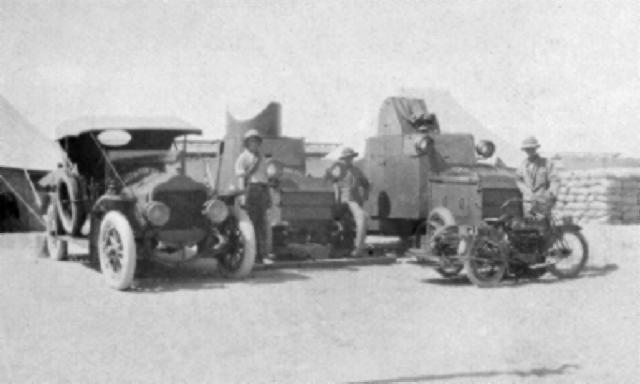Topic: AIF - Cars
1st AUSTRALIAN ARMOURED CAR SECTION, AIF
THE FIRST AUSTRALIAN ARMOURED CAR SECTION
Below is a transcription from a manuscript submitted by Captain E.H. James called "The Motor Patrol". It is lodged in the AWM as AWM 224 MSS 209.
THE FIRST AUSTRALIAN ARMOURED CAR SECTION
In August 1914 when the dogs of War were let loose a number of motoring enthusiasts met together in Melbourne to talk over a scheme for building Armoured Cars for use with the Allied Armies and to form a unit to volunteer for service abroad. Cold water was thrown on the schema from almost every quarter as there was practically no information available as to what the proper design for an armoured car should be; how the guns should be mounted; what the equipment should consist of and .hat the personnel should be.
Still fools rush in where angels fear to tread and being enthusiasts they persisted. After many months of searching and enquiries from various quarters, enough information was available to enable designs to be got out. Then other obstacles cropped up. Armoured Cars were very expensive luxuries and required commodious high powered chassis to carry then. Armour plating and other expensive equipment was required. Three powerful chassis were donated for the purpose by Mr. John Young of Horsham, Mr. P. Cornwall of Coburg and Mr. Sol Green of Melbourne. Designs and specifications that were drawn up were approved and ultimately through the untiring efforts of Colonel Osborne, authority was given for the unit to be formed and got ready as soon as possible for service at the front, the Imperial Government having accepted the offer of the unit complete. The necessary personnel were soon enrolled as members of the tat. Australian Armoured Car Section and they began to get busy.
The use of the plant at the Vulcan Engineering Works, South Melbourne vas obtained and as quite a number of the section were skilled engineers they decided to make the necessary alterations to the chassis and build the armour and gun mountings themselves.
Several Melbourne firms also vary kindly gave considerable assistance by supplying valuable equipment. Conspicuous amongst these donors were the Victoria Rolling Mills, Messrs. J. A. Linacre, W. Till and W. P. Thompson & Co.
It was found that many difficulties had to be overcome, the greatest of these being the obtaining of suitable bullet resisting plate for the protection of the inmates and the vulnerable parts of the chassis. Ordinary steel plating of the required thickness would be far too heavy to be of any use at all. Many suggestions were made by individuals who were prepared to sell us all kinds of wonderful metal and processes for toughening and hardening ordinary steel plate. We insisted that there was only one test, as far as we were concerned and that was the service bullet. Many tests were made at the rifle ranges and all these bullet proof metals were found useless. We also discovered that although these merchants were positive of the qualities of their plating none of them had enough faith in it to stand behind while rifles were fired at it.
One inventor in particular was quite amusing. He had en alloy which appeared to contain a large percentage of aluminium and which ha claimed was extremely light and quite bullet proof at point blank range. He even went to the trouble of making a special helmet with which he wished the authorities to supply the troops at the front. During our tests we got one of our marksmen to try a shot at this helmet at a range of a couple of hundred yards. The bullet drilled a neat hole through the front but knocked a piece out of the back several inches square. The inventor's face was a picture when we gave him back his helmet. He apparently had no knowledge of the power of the modern 303 bullet.
Ultimately we got over our armour plate trouble as we discovered that there was a small supply in Melbourne of the special 3/32" steel plate imported from England some time previously for plating ammunition wagons. This steel is absolutely bullet proof at 500 yards and by doubling it, is proof at a much shorter range. We were fortunate in being able to purchase a supply of this and we used it in double thicknesses and in some places treble thicknesses on the vehicles. Louvres were fitted In front of the radiators. Colt Automatic gone were mounted is turrets (one on the top of each car). The turrets were revolving giving a complete arc of fire of 360o and a spare gun was carried inside each vehicle. On tests we found our cars were capable of a speed of between 50 to 60 miles per hour with their full load.

The crews went through intensive courses of machine gun instruction and as the majority were very experienced motor car drivers, the personnel were in the ideal position of being able at a moment's notice to take the place of any vacancy through casualty or otherwise. Towards the and of 1915 the authorities were satisfied that the unit was well enough advanced for embarkation although it was well into 1916 before the got away on the old transport A.13 HMAS Katuna, en route for an unknown port.
The account of this boat's peregrinations and how she took eight weeks from Melbourne to Suez sometimes drifting about in the Indian Ocean with engines broken down during the monsoons which were particularly severe, would fill a book; but ultimately men and cars ware disembarked at Port Tewfik and sent by rail to join the Australian forces in Egypt.
Previous section: No previous section.
Next section: 1st Australian Armoured Car Section - THE LIBYAN DESERT
Further Reading:
1st AUSTRALIAN ARMOURED CAR SECTION, AIF, Contents
Australian Light Horse Order of Battle - Outline
The Australian Light Horse - StructureAustralian Light Horse Order of Battle
Battles where Australians fought, 1899-1920
Citation: 1st Australian Armoured Car Section - THE FIRST AUSTRALIAN ARMOURED CAR SECTION



